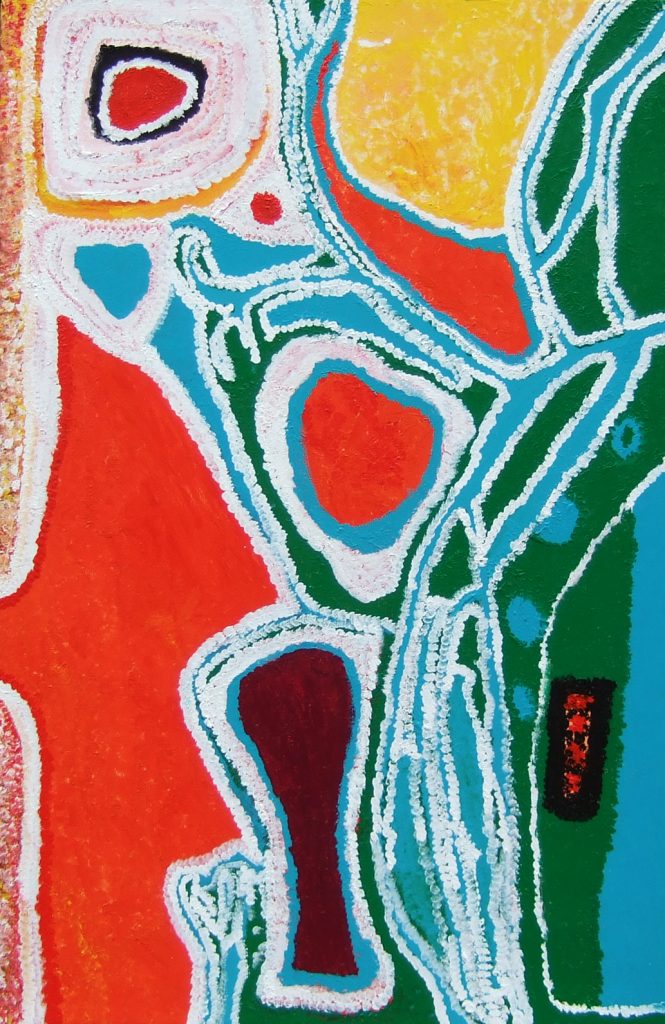
Netta Loogatha, Makarrki, 2009, acrylic on canvas, 151 x 101 cm. AAMU Collection. Courtesy AAMU, Utrecht, The Netherlands
Tracking Memories: reflecting on sixteen years of groundbreaking exhibitions
Tracking Memories is about exploring the collective memory, culture and history of a country and a people. In this exhibition connections are made between the works of artists from three continents – Australia, Europe and Africa. This final exhibition at the AAMU Museum of contemporary Aboriginal art in Utrecht will be on display from 22 January to 15 June 2017. After that the museum will close permanently, as announced previously.
In Tracking Memories. Memory of country, the AAMU looks back on sixteen years of groundbreaking exhibitions, in which Aboriginal art was often presented in combination with international contemporary art.
Dialogue
In this exhibition, which is rich both visually and in content, Aboriginal artworks, European contemporary art and African sculptures enter into a dialogue with each other and merge into one installation. How do artists depict their country’s collective memory? How do these artists from different countries and continents perceive the complexity of history? The works shown in Tracking Memories provide food for reflection on Western history, the colonial past and its continuing influence on current life in Africa, Australia and Europe.
The country’s memory
Aboriginal artworks contain the memory of the country’s creation. Memory plays a significant role in Aboriginal art and culture, which is passed on not only orally but also visually. In various artworks, memories of the creation of the country are made visible in certain patterns, such as the concentric circles and the lines connecting them. The circles in these paintings represent important places which carry the country’s memory.
During creation journeys, the Ancestors left traces in particular features of the country. People can still track certain routes by following these traces. The artworks show these journeys of the Ancestors from one place of memory to another. Tracking Memories displays a large number of paintings from the AAMU’s museum collection.
European perspective
The exhibition includes mixed media work by Belgian visual artist Danny Matthys, consisting of collages of photographs, educational prints and postcards, and acrylic. The oeuvre of Danny Matthys (1947) plays a key role in Tracking Memories. In European culture, photos and prints are the main medium for recording memories – memories of trips, of family members and friends, and of history. It is a popular way to pass on memories of people and events to the following generations.
The title of the exhibition was taken from a series of his works which focus on memory. As an artist, Matthys has connections both with Australia and Aboriginal art and culture and with Belgium’s African past. African colons – wooden statues of colonial figures – often feature in his work. Australia is also explicitly present in his work in the use of personal photos and other visual material and in the dot painting technique often typical of Aboriginal art from the desert areas.
Other European artworks in the exhibition are by the artists Dirk Zoete, Hugo Debaere and Kristof van Gestel.
The African colons
Dozens of the statues from Africa known as colons will be exhibited. The origins of these wooden figures lie in the traditional woodcarving of West and East Africa. Originally, the statues were of colonists, but over time they gradually changed into sculptures of African people. These statues are shown in combination with the works by Danny Matthys.
The colons carry the memory of Africa’s history. They tell not only the story of the development of woodcarving in various African regions, but also the story of colonisation in these areas and of the emancipation of the African population.
SOURCE
ARTICLE
Fate of AAMU and its Collection, Aboriginal art directory, 11 January 2017